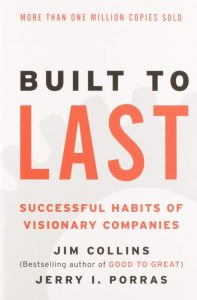
# Key Takeaways:
– Companies that are built to last have a strong core ideology that guides their decisions and actions.
– These companies also have a clear and compelling vision for the future, which serves as a unifying force for their employees.
– Built to last companies have a culture of discipline, where they focus on their core competencies and consistently deliver high-quality products or services.
– They also have a long-term orientation, prioritizing sustainable growth over short-term gains.
– Built to last companies have a strong leadership team that is aligned with the company’s core values and vision.
# Practical Application:
– Companies can apply the concept of core ideology by identifying their core values and purpose, and using them as a guide for decision-making and strategy development.
– Having a clear and compelling vision can help companies align their employees towards a common goal and motivate them to work towards it.
– Building a culture of discipline involves focusing on the company’s strengths and consistently delivering high-quality products or services.
– Companies can adopt a long-term orientation by prioritizing sustainable growth and investing in the future, rather than focusing solely on short-term profits.
– Developing a strong leadership team that is aligned with the company’s core values and vision can help drive the company towards success.
# Valuable Insights for Leaders and Managers:
– Chapter 2: “Clock Building, Not Time Telling” emphasizes the importance of building a strong foundation for the company, rather than relying on individual leaders.
– Chapter 3: “Preserve the Core/Stimulate Progress” discusses the balance between maintaining the company’s core values and constantly evolving to stay relevant.
– Chapter 4: “Big Hairy Audacious Goals (BHAGs)” highlights the importance of setting ambitious and inspiring goals for the company.
– Chapter 5: “Cult-Like Cultures” delves into the power of a strong company culture and how it can drive success.
– Chapter 6: “Try a Lot of Stuff and Keep What Works” encourages companies to experiment and learn from failures in order to innovate and improve.
# Effective Case Studies and Examples:
– The comparison between General Electric and Westinghouse in Chapter 1 effectively illustrates the difference between a company that is built to last and one that is not.
– The story of 3M’s Post-it Notes in Chapter 6 showcases how a company’s culture of experimentation and innovation can lead to successful products.
– The example of Johnson & Johnson’s handling of the Tylenol crisis in Chapter 7 demonstrates the importance of a strong core ideology and values in times of crisis.
– The case study of Disney in Chapter 8 highlights the power of a clear and compelling vision in driving the company’s success.
– The example of IBM’s transformation in Chapter 9 shows how a company can adapt and evolve while still staying true to its core values.
Built to last is a study of 18 visionary companies which they thoroughly analysed and compared with non-visionary companies. Their goal was to figure out what helped visionary companies stay successful for so long. The book is the result of over 6 years of extensive research with surveys from over 100 CEOs from top companies.
Principles in Built To Last
Here are some principles that set apart Visionary Companies from Comparison Companies and help create success that lasts for decades:
1. Timeless Foundation:
- The truth of the matter is that visionary companies’ achievement of long-lasting success doesn’t come just from great ideas or visionary leadership. Instead, they achieve such success because of the super-strong foundation that has been embedded in the organization.
- This foundation allows them to succeed over leaps and bounds, across different leaders and product cycles.
- They focus on organisational design as opposed to particular ideas that outlast their product lines.
2. And Not Or
- Visionary companies don’t hold themselves down to the negative effects of Or. They never pick between this OR that
- They believe in working towards achieving a balance between both extremes of this AND that. E.g. profits AND purpose, low cost AND high quality, stability AND change etc.
3. More Than Just Profits:
- They persevere to fulfil their objectives in which money and profits play one of the many significant functions.
- Profit plays a vital role but is not their main drivers for fulfiling their purpose. At their core, they are purpose-oriented rather than profit-oriented.
4. Retain the core, strive for progress:
- A visionary company takes all the initiatives for progress without compromising its fabric core values.
- Such companies embrace the dynamics of both, core values and progress.
Mechanism of Built To Last Companies:
- Big Hairy Audacious Goals(BHAGs):These are powerful tools used to stimulate and incite progress. These are aligned with core beliefs in mind and are compelling in nature. They are high impact goals that do not lie withing the comfort zone.
- Cultic Culture:Their core values don’t leave space for compromises, meaning either you are in or out.There is no in-between when it comes to core believes. Such companies will only go for the best people who are in alignment with their system of core ideology.
- Vigorous Experimentation:Despite being strongly organised and planned, most breakthroughs in such companies happen through experimentation and error and trial methods.
- Home Grown Leadership:Visionary companies are 6 times more likely to pick and promote people from within the organisation to top-level management as compared to non-visionary companies.This helps preserves the core values and continuity of leadership.
- Nothing Is Good Enough:The process of improvement is an institutional habit in such companies. They are constantly thinking and searching for ways to improve. This helps combat a slacking environment and the guilt of complacency.
Leave a Reply